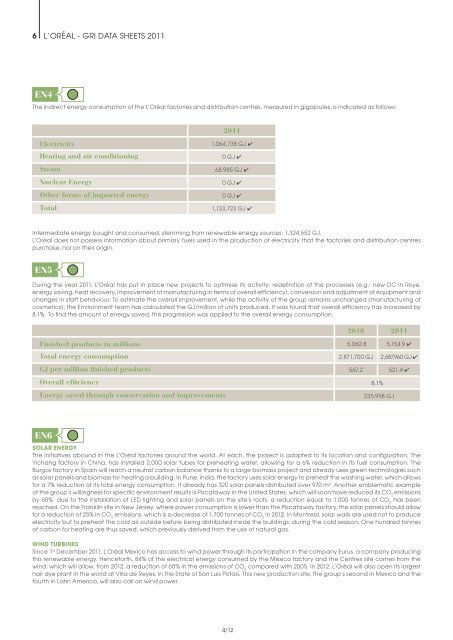Organizational Strategy - Sustainable Development - L'Oréal
Organizational Strategy - Sustainable Development - L'Oréal
Organizational Strategy - Sustainable Development - L'Oréal
You also want an ePaper? Increase the reach of your titles
YUMPU automatically turns print PDFs into web optimized ePapers that Google loves.
6 L’oréaL - GrI DaTa SHEETS 2011<br />
EN4<br />
The indirect energy consumption of the L’oréal factories and distribution centres, measured in gigajoules, is indicated as follows:<br />
2011<br />
Electricity 1,064,738 GJ 4<br />
Heating and air conditioning 0 GJ 4<br />
Steam 68,985 GJ 4<br />
Nuclear Energy 0 GJ 4<br />
Other forms of imported energy 0 GJ 4<br />
Total 1,133,723 GJ 4<br />
Intermediate energy bought and consumed, stemming from renewable energy sources: 1,324,552 GJ.<br />
L’oréal does not possess information about primary fuels used in the production of electricity that the factories and distribution centres<br />
purchase, nor on their origin.<br />
EN5<br />
During the year 2011, L’oréal has put in place new projects to optimise its activity: redefinition of the processes (e.g.: new DC in roye,<br />
energy saving, heat recovery, improvement of manufacturing in terms of overall efficiency), conversion and adjustment of equipment and<br />
changes in staff behaviour. To estimate the overall improvement, while the activity of the group remains unchanged (manufacturing of<br />
cosmetics), the Environment team has calculated the GJ/million of units produced. It was found that overall efficiency has increased by<br />
8.1%. To find the amount of energy saved, this progression was applied to the overall energy consumption.<br />
SOLAR ENERGY<br />
The initiatives abound in the L’oréal factories around the world. at each, the project is adapted to its location and configuration. The<br />
Yichang factory in China, has installed 2,000 solar tubes for preheating water, allowing for a 6% reduction in its fuel consumption. The<br />
Burgos factory in Spain will reach a neutral carbon balance thanks to a large biomass project and already uses green technologies such<br />
as solar panels and biomass for heating a building. In Pune, India, the factory uses solar energy to preheat the washing water, which allows<br />
for a 7% reduction of its total energy consumption. It already has 320 solar panels distributed over 970 m 2 . another emblematic example<br />
of the group’s willingness for specific environment results is Piscataway in the United States, which will soon have reduced its Co 2 emissions<br />
by 60%: due to the installation of LED lighting and solar panels on the site’s roofs, a reduction equal to 1,000 tonnes of Co 2 has been<br />
reached. on the Franklin site in New Jersey, where power consumption is lower than the Piscataway factory, the solar panels should allow<br />
for a reduction of 25% in Co 2 emissions, which is a decrease of 1,700 tonnes of Co 2 in 2012. In Montreal, solar walls are used not to produce<br />
electricity but to preheat the cold air outside before being distributed inside the buildings, during the cold season. one hundred tonnes<br />
of carbon for heating are thus saved, which previously derived from the use of natural gas.<br />
WIND TURBINES<br />
Since 1 st December 2011, L’oréal Mexico has access to wind power through its participation in the company Eurus, a company producing<br />
this renewable energy. Henceforth, 84% of the electrical energy consumed by the Mexico factory and the Centrex site comes from the<br />
wind, which will allow, from 2012, a reduction of 60% in the emissions of Co 2 compared with 2005. In 2012, L’oréal will also open its largest<br />
hair dye plant in the world at Villa de reyes, in the State of San Luis Potosí. This new production site, the group’s second in Mexico and the<br />
fourth in Latin america, will also call on wind power.<br />
4/12<br />
2010 2011<br />
Finished products in millions 5,062.8 5,154.9 4<br />
Total energy consumption 2,871,700 GJ 2,687,960 GJ 4<br />
GJ per million finished products 567.2 521.4 4<br />
Overall efficiency 8.1%<br />
Energy saved through conservation and improvements 235,998 GJ<br />
EN6






